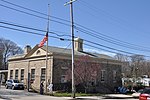Fore River Shipyard was a shipyard owned by General Dynamics Corporation located on Weymouth Fore River in Braintree and Quincy, Massachusetts. It began operations in 1883 in Braintree, and moved to its final location on Quincy Point in 1901. In 1913, it was purchased by Bethlehem Steel, and later transferred to Bethlehem Shipbuilding Corporation. It was sold to General Dynamics in 1963, and closed in 1986. During its operation, yardworkers constructed hundreds of ships, for both military and civilian clients.
Most of the ships at the yard were built for the United States Navy, with its first government contract for the destroyer USS Lawrence (DD-8). The yard also built early submarines for Electric Boat, including USS Octopus (SS-9) and USS Sunfish (SSN-649). Fore River also constructed the battleship USS Massachusetts (BB-59), and the cruisers USS Springfield (CL-66) and USS Salem (CA-139) as well as the Navy's first carrier USS Lexington (CV-2) and its successor USS Lexington (CV-16). Fore River produced multiple foreign ships for various navies around the world including five Type 1 submarines for the Imperial Japanese Navy, ten submarines for the Royal Navy, and the battleship ARA Rivadavia, for the Argentine Navy.
The yard constructed several merchant marine ships, including Thomas W. Lawson, the largest pure sailing ship ever built, and SS Marine Dow-Chem, which was the first ship constructed to carry refrigerated chemicals. General Dynamics Quincy Shipbuilding Division, as it eventually came to be known, ended its career as a producer of various LNG tankers and merchant marine ships.
The yard would also construct a number of American flagged passenger liners, which included Matson Line's SS Mariposa, SS Monterey, SS Lurline, along with American Export Lines SS Independence and SS Constitution.According to one theory, the yard was the origin of the "Kilroy was here" pop culture reference, and was home to the second-largest shipbuilding crane in the world. During the period in which it was operable, the yard had two sub-yards: the first was the Victory Destroyer Plant in Quincy during World War I, and the second was the Bethlehem Hingham Shipyard in Hingham during World War II. In addition, the yard owned Bethlehem Atlantic Works, a drydock facility which was located in East Boston.








